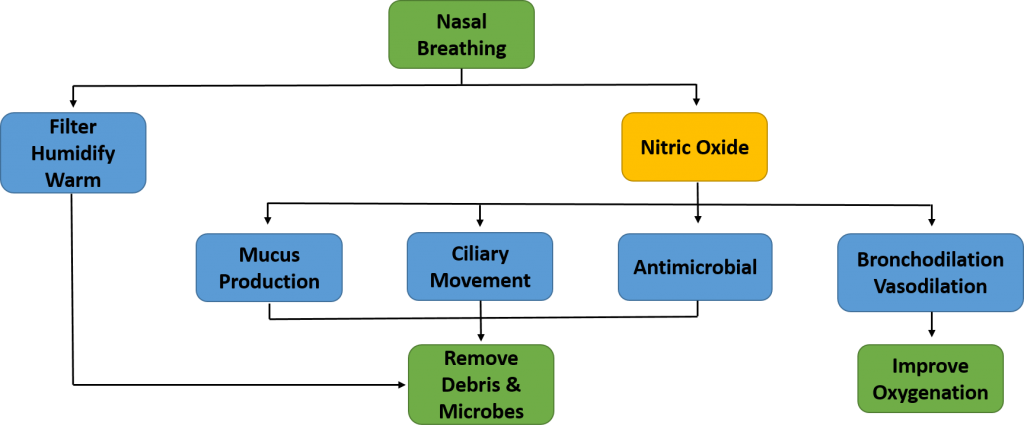Breathe Through Your Nose
- At August 27, 2020
- By Healing In Motion
- In Uncategorized
 0
0
This post is inspired by “Following Your Nose: Nasal Function and Energy” by Rudolph Ballentine (in Science of Breath, 1992).
The nose is the most restricted part of the respiratory tract and creates 150% more work than mouth breathing. So why should we breathe through our noses? Because the nose fulfils several crucial respiratory functions that our mouth is unable to fulfil. As air passes through the nose it’s filtered, humidified (98% humidity) and warmed (32-34 degrees C). This prepares it for passage to the lungs. When we breathe out through the nose, much of the moisture and heat is retained within the nose to be transferred to the next in-breath.
As we breathe deeply through our nose, mechanoreceptors on epithelial cells are activated and this results in the release of nitric oxide. Nitric oxide leads to bronchodilation and vasodilation which in turn increase circulation and the delivery of oxygen. Nitric oxide also has antimicrobial properties and promotes mucus production and ciliary movement which facilitate the evacuation of debris and microbes.
Apparently, the shape of our nose depends on the climate in which our ancestors evolved: a long big nose in cooler and dryer climates and a wide nose with open nostrils in warm, moist climates.

Slow Breathing Regulates High Blood Pressure
- At March 30, 2020
- By Healing In Motion
- In Tips
 0
0
Several years ago I wrote a few articles showing that exercise, yoga and other strategies were helpful at regulating high blood pressure (BP). Even small reductions in blood pressure can significantly reduce the risk of heart disease, stroke and kidney failure. The risks associated with hypertension are continuous – this means that with each 2mm Hg rise in systolic BP there is an associated 7% increase in mortality from heart disease and 10% increase in mortality from stroke.
I recently came across a few studies that have shown that paced, slow breathing can significantly decrease blood pressure in patients with hypertension. Joseph et al. (2005) demonstrated that paced breathing at 6 breaths/min for only a couple of minutes was able to decrease systolic BP by more than 8mm Hg and diastolic BP by about 5mm Hg. Similarly, Li et al. (2018) found that paced breathing at 8 breaths/min for 5min lowered systolic BP by about 4mm Hg and diastolic BP by over 8mm Hg. Because the slow breathing was only tested for a few minutes…the long-term effects of daily practice remain to be determined.
For those that are interested in giving it a go, I would recommend wearing loose-fitting clothing and either lying down or sitting back into a chair in a warm environment. Aim to progressively slow your breathing down to 5-7 breaths/min (there are several apps that can help pace your breathing). Breathe with an equal inhalation and exhalation. It may take several sessions to comfortably slow your breath to 5-7 breaths/min…take your time. Enjoy for 15-20min a day!

- At February 16, 2015
- By Healing In Motion
- In Quote
 0
0
“Breathing is the link between body and mind.
The breath can lead the body toward wellness and the mind toward calmness.”
A G Mohan
Breathing Exercises Help Treat PTSD
- At September 21, 2014
- By Healing In Motion
- In Research
 0
0
A study by Seppala et al, published in last month’s issue of the Journal of Traumatic Stress, looked into the effects of yogic breathing on war veterans with post traumatic stress disorders (PTSD). They found that after the course of controlled breathing exercises the test subjects had reductions in PTSD scores, anxiety symptoms, respiration rate, startle signs and other hyperarousal symptoms. The benefits were still present 1 year later. It’s thought that the breathing exercises help balance the autonomic nervous system.





